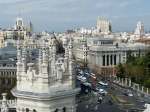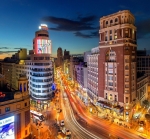Information about Madrid
Madrid is the capital of Spain as well as the Spanish city that attracts the most visitors. With more than 10 million visitors in 2018, Madrid ranks among one of the most popular cities in Europe.
The city has a nominal GDP of USD 227,411 million and a nominal GDP per capita of USD 34,425, representing a PPP GDP per capita of USD 40,720, being the 1st Spanish metropolitan area in economic activity; and the tenth of Europe after London, Paris, Rin-Ruhr, Amsterdam, Milan, Brussels, Moscow, Frankfurt am Main and Munich. Madrid is also the Spanish city with the most hotel overnight stays.
It is an influential cultural center and has museums of international reference, among which the Prado Museum, the Reina Sofía National Art Center Museum, the Thyssen-Bornemisza and CaixaForum Madrid
Emir Muhammad I (852-886) had a fortress built on the banks of the Manzanares, known in the Arabic texts as Mayrit, (Magerit in its Castilianized form).
The fortress was built in the place that today occupies the Royal Palace with the purpose of monitoring the footsteps of the Sierra de Guadarrama and being the starting point of razzias against the Christian kingdoms of the north.
This fortress was temporarily occupied in the year 932 by Ramiro II and later Alfonso VI included it among the territories won to al-Andalus. Around the old fortified enclosure the town of Madrid had to grow, favored by the repopulation measures of the monarchs, among which the granting of the jurisdiction in 1202 stands out.
However, Madrid did not become truly important until Felipe II moved the court there in 1561. When the court was established, the need for urban reforms became apparent and suburbs soon emerged outside the medieval precinct.
As the urban area increased, the number of inhabitants increased, from 4,060 in the year 1530 to 37,500 in the year 1594. In April 1637 there were 1,300 "legitimate and disabled" poor people in the court and 3,300 asking for alms, the largest foreigners, former pilgrims from Santiago and former soldiers.










